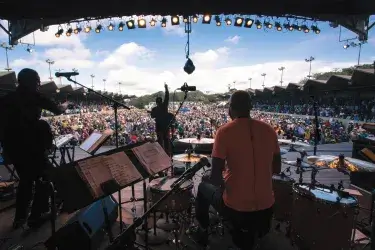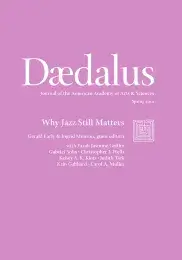
Why Jazz Still Matters
Jazz: it has been called both cool and hot, earthy and avant-garde, intellectual and primitive. It is improvisational music touted for the freedom it permits its players, but in its heyday was largely composed and tightly arranged. It tells a story about race in America: not only because African American musicians were so central in its creation and African American audiences so important in their creative responses to it, but because whites played such a dominant role in its dissemination through records and performance venues and its ownership as intellectual and artistic property. But is jazz a relic of the past, or does it continue to have meaning and influence for today’s artists and audiences? And while it may still be present, does it still matter?
Following Geri’s Lead
Drawn from a keynote delivered for Timeless Portraits and Dreams: A Festival in Honor of Geri Allen (Harvard University, February 16–17, 2018), this personal essay shares observations about Allen’s intellectual and artistic leadership in diverse roles including bandleader, teacher, curator, and artistic visionary. In addition to discussions of Allen’s music and recordings, this essay also focuses on her collaboration with the author and actor/director S. Epatha Merkerson, which resulted in two musical theater projects, Great Jazz Women of the Apollo (2013) and A Conversation with Mary Lou (2014).
Soul, Afrofuturism & the Timeliness of Contemporary Jazz Fusions
The rise of jazz-R&B-hip hop fusions in contemporary Los Angeles offers an opportunity to reflect on the ways jazz matters to black audiences today. Drawing on recent Afrofuturist art and theory as well as on Amiri Baraka’s analysis of the “changing same” in black music, this essay traces out the significance of work by artists as diverse as Kamasi Washington, Flying Lotus, Thundercat, and Robert Glasper, positing that their music tells us that jazz matters not only in itself, but also in its continuing capacity to engage in cross-genre dialogues for musicians and audiences who hear it as part of a rich continuum of African American musical expression.
“You Can’t Dance to It”: Jazz Music and Its Choreographies of Listening
Central to dominant jazz history narratives is a midcentury rupture where jazz transitions from popular dance music to art music. Fundamental to this trope is the idea that faster tempos and complex melodies made the music hostile to dancing bodies. However, this constructed moment of rupture masks a longer, messier process of negotiation among musicians, audiences, and institutions that restructured listening behavior within jazz spaces. Drawing from the field of dance studies, I offer the concept of “choreographies of listening” to interrogate jazz’s range of socially enforced movement “scores” for audience listening practices and their ideological significance. I illustrate this concept through two case studies: hybridized dance/concert performances in the late 1930s and “off-time” bebop social dancing in the 1940s and 1950s. These case studies demonstrate that both seated and dancing listening were rhetorically significant modes of engagement with jazz music and each expressed agency within an emergent Afromodernist sensibility.
Dave Brubeck’s Southern Strategy
In January 1960, white jazz pianist Dave Brubeck made headlines for cancelling a twenty-five-date tour of colleges and universities across the American South after twenty-two schools had refused to allow his black bassist, Eugene Wright, to perform. This cancellation became a defining moment in Brubeck’s career, forever marking him as an advocate for racial justice. This essay follows Brubeck’s engagement with early civil rights–era protests, examining the moments leading up to Brubeck’s cancellation of his 1960 tour of the South. In doing so, I uncover new details in Brubeck’s steps toward race activism that highlight the ways in which Brubeck leveraged his whiteness to support integration efforts, even as he simultaneously benefited from a system that privileged his voice over the voices of people of color. While Brubeck has been hailed as a civil rights advocate simply for cancelling his 1960 tour, I argue that Brubeck’s activism worked on a deeper level, one that inspired him to adopt a new musical and promotional strategy that married commercial interests with political ideology. Brubeck’s advocacy relied on his power and privilege within the mainstream music industry to craft albums and marketing approaches that promoted integration in the segregationist South. Ultimately, this period in Brubeck’s career is significant because it allows deep consideration of who Brubeck spoke for and above, who listened, and for whom his actions as a civil rights advocate were meaningful.
Keith Jarrett, Miscegenation & the Rise of the European Sensibility in Jazz in the 1970s
In the 1970s, pianist Keith Jarrett emerged as a major albeit controversial innovator in jazz. He succeeded in making completely improvised solo piano music not only critically acclaimed as a fresh way of blending classical and jazz styles but also popular, particularly with young audiences. This essay examines the moment when Jarrett became an international star, the musical and social circumstances of jazz music immediately before his arrival and how he largely unconsciously exploited those circumstances to make his success possible, and what his accomplishments meant during the 1970s for jazz audiences and for American society at large.
Ella Fitzgerald & “I Can’t Stop Loving You,” Berlin 1968: Paying Homage to & Signifying on Soul Music
“If you don’t learn new songs, you’re lost,” Ella Fitzgerald told The New York Times in 1967. This essay is a close reading of one performance of “I Can’t Stop Loving You” she gave at a concert in Berlin on February 11, 1968. The song, which had already become a global hit through a version by Ray Charles in 1962, turned into a vehicle through which Fitzgerald signified on “Soulsville,” or soul, a black popular style then sweeping the American music scene. References to Aretha Franklin’s “Respect” and Vernon Duke’s “I Can’t Get Started With You” are examples of the interpolations included here. The essay challenges the idea that the late 1960s were a fallow period in Fitzgerald’s career by highlighting the jazz techniques she used to transform one song into a self-revelatory theatrical tour de force.
La La Land Is a Hit, but Is It Good for Jazz?
The debates around La La Land (2016) tell us a great deal about the state of jazz today and perhaps even in the near future. Many critics have charged that the film has very little real jazz, while others have emphasized the racial problematics of making the white hero a devout jazz purist while characterizing the music of the one prominent African American performer (John Legend) as all glitz and tacky dance moves. And finally, there is the speech in which Seb (Ryan Gosling) blithely announces that “jazz is dead.” But the place of jazz in La La Land makes more sense if we view the film as a response to and celebration of several film musicals, including New York, New York (1977), the Fred Astaire and Ginger Rogers films, and especially Jacques Demy’s The Young Girls of Rochefort (1967). Both La La Land and Demy’s film connect utopian moments with jazz, and push the boundaries of the classical Hollywood musical in order to celebrate the music.
Yusef Lateef’s Autophysiopsychic Quest
Yusef Lateef’s neologism for jazz was autophysiopsychic, meaning “music from one’s physical, mental and spiritual self.” Lateef condensed in this term a very considered conception linking the intellectual and the spiritual based in his faith as an Ahmadiyya Muslim and his lifelong commitment to both Western and non-Western intellectual explorations. Lateef’s distinctive voice as an improviser is traced with respect to his autophysiopsychic exploration of world instruments including flutes, double reeds, and chordophones, and his friendship with John Coltrane. The two shared a love of spiritual exploration as well as the study of science, physics, symmetry, and mathematics. Lateef’s ethnomusicological research on Hausa music in Nigeria, as well as his other writings and visual art, deepen our understanding of him as an artist-scholar who cleared the way for the presence of autophysiopsychic musicians in the academy.
Why Jazz? South Africa 2019
I consider the current state of jazz in South Africa in response to the formation of the nation-state in the 1990s. I argue that while there is a recurring sense of the precarity of jazz in South Africa as measured by the short lives of jazz venues, there is nevertheless a vibrant jazz culture in which musicians are using their own studios to experiment with new ways of being South African through the freedom of association of people and styles forming a music that sounds both local and comfortable in its sense of place in the global community. This essay uses the words of several South African musicians and concludes by situating the artistic process of South African artist William Kentridge in parallel to jazz improvisation.
